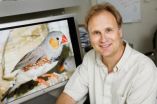"It's like a dimmer switch, or rheostat, that helps control the level of p53 activity in a critical stem cell population and the offspring they generate," says Geoffrey M. Wahl, professor in the Salk Institute's Gene Expression Laboratory, and senior author of the study, which appears online in the journal Genes & Development on July 1, 2011. "In principle, controlling this switch with drugs could reduce the unwanted effects from DNA-damaging chemotherapy or radiation treatment, allowing higher doses to be used."
The protein p53 is an important tumor suppressor because it can destroy or halt the growth of cells that develop potential cancer-causing DNA mutations. But as Wahl's lab and others have shown over the past several years, p53 has much broader importance in the life and death of cells. "It's critical for determining whether a cell survives stress and continues to function in a variety of situations," says Wahl.
One problem with p53 is that it apparently evolved to protect the integrity of the genome for future generations, rather than to prolong the lives of individual cells or animals. From the point of view of an animal, p53 sometimes goes too far in killing cells or suppressing growth. Experiments in mice have suggested that even modest reductions in p53's activity greatly increases survival after exposure to radiation, without raising the long-term cancer risk to unacceptable levels.
Scientists therefore are eager to find out how cells naturally regulate p53, so that they can target these mechanisms with drugs. One clue uncovered by recent studies is that regulatory molecules can alter p53 activity by chemically modifying some key amino acids. In the current study, Wahl and colleagues set out to illuminate the function of a stretch of regulatory amino acids at one end of the protein by creating "designer" mice with other amino acids in this region, thereby rendering it inoperative.
The mutant mice had somewhat higher p53 activity than normal mice, at least in some tissues. Based on other studies, Wahl's team expected the mutants to age faster. To their surprise, however, the mutant mice lived about as long as ordinary, "wild type" mice. A second surprise came when Wahl's team exposed the mice to ionizing radiation, of the sort that nuclear power plants may emit. While all the normal mice survived, half the mutant mice died within four weeks.
To understand why the mutant mice died so readily, Vivian Wang, a postdoc in Wahl's lab, collaborated with the Salk veterinarian, Mat Leblanc, and hematologists at UCSD and noted that the irradiated mutant mouse hearts became enlarged and pale, as if they had been starved of oxygen. "Eventually, we found the reason for this," Wahl explains. "We found that irradiation and the ensuing p53 response significantly damaged the blood-forming cells of their bone marrow, but other parts of their bodies seemed quite normal. We followed up these studies with stem cell transplantation experiments to show the mutant p53 really affected the stem cells and their descendents that make the blood."
These results led the team to conclude that the loss of function of p53's normal "dimmer-switch" segment had allowed the protein to become too active in the hematopoietic stem cells of the mutant mice, arresting the stem cells' proliferation and preventing them from replacing the blood cells lost to irradiation. "If the stem cells and their descendants are arrested for too long, they can't recover fast enough, and the mice eventually die of the effects of insufficient oxygenation of critical tissues," Wahl says.
The team then studied how p53 activation could cause these cells to arrest for too long. Using sophisticated new techniques, they found that p53 lacking its "dimmer switch" turned on too much of a gene called p21, which acts as a brake to halt cells from dividing. "To confirm the significance of that finding, we created mice that expressed the mutant p53, but had only one instead of the normal two copies of p21," Wahl says. "This reduced p21 levels after irradiation. Remarkably, this was enough to significantly reduce the mortality of the 'dimmerless' p53 mice. They were much less sensitive to radiation when they just had one less copy of p21."
The study underscores the importance of an evolutionarily conserved regulatory segment of p53 and the importance of p53 activity in the response to conditions that produce DNA damage. "Our study indicates that the amount of damaged DNA caused by radiation or toxins, isn't the sole determinant of life or death," says Wahl. "The extent to which p53 is also very important."
One implication of this research is that drugs to lower p53 levels, or to reduce its transcription of other growth-stopping genes such as p21, might be used temporarily to reduce unwanted tissue damage from DNA-altering drugs or radiation. Another implication is that p53-boosting drugs, which are currently being tested in cancer patients, could have dangerous side effects if used in combination with other drugs that cause DNA damage. "Our mouse model suggests that if you use a p53-activating agent, the last thing you should do is combine it with a general DNA-damaging chemotherapy or radiotherapy," Wahl says.
INFORMATION:
The lead author of the study was Yunyuan ("Vivian") Wang, PhD, at the time a postdoctoral researcher in Wahl's lab, and now a project scientist at the University of California, Irvine. The other coauthors were Mathias Leblanc, Kurt Krummel and Danielle Engle, of the Salk Institute's Gene Expression Laboratory; Norma Fox and Kenneth Kaushansky, MD, of the University of California, San Diego; Jian-Hua Mao and Allan Balmain of the Helen Diller Family Comprehensive Cancer Center, at the University of California, San Francisco; and Kelsey L. Tinkum, David Piwnica-Worms and Helen Piwnica-Worms of the Mallinckrodt Institute of Radiology at Washington University Medical School in St. Louis. Funding provided by the National Cancer Institute.
About the National Cancer Institute (NCI): as part of the National Institutes of Health (NIH), one of 11 agencies that compose the Department of Health and Human Services (HHS), the NCI, established under the National Cancer Institute Act of 1937, is the Federal Government's principal agency for cancer research and training. The National Cancer Act of 1971 broadened the scope and responsibilities of the NCI and created the National Cancer Program. Over the years, legislative amendments have maintained the NCI authorities and responsibilities and added new information dissemination mandates as well as a requirement to assess the incorporation of state-of-the-art cancer treatments into clinical practice. NCI coordinates the National Cancer Program, which conducts and supports research, training, health information dissemination, and other programs with respect to the cause, diagnosis, prevention, and treatment of cancer, rehabilitation from cancer, and the continuing care of cancer patients and the families of cancer patients.
About the Salk Institute for Biological Studies: The Salk Institute for Biological Studies is one of the world's preeminent basic research institutions, where internationally renowned faculty probe fundamental life science questions in a unique, collaborative, and creative environment. Focused both on discovery and on mentoring future generations of researchers, Salk scientists make groundbreaking contributions to our understanding of cancer, aging, Alzheimer's, diabetes and infectious diseases by studying neuroscience, genetics, cell and plant biology, and related disciplines.
Faculty achievements have been recognized with numerous honors, including Nobel Prizes and memberships in the National Academy of Sciences. Founded in 1960 by polio vaccine pioneer Jonas Salk, M.D., the Institute is an independent nonprofit organization and architectural landmark.
END




